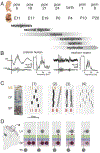Transient cortical circuits match spontaneous and sensory-driven activity during development
- PMID: 33060328
- PMCID: PMC8050953
- DOI: 10.1126/science.abb2153
Transient cortical circuits match spontaneous and sensory-driven activity during development
Abstract
At the earliest developmental stages, spontaneous activity synchronizes local and large-scale cortical networks. These networks form the functional template for the establishment of global thalamocortical networks and cortical architecture. The earliest connections are established autonomously. However, activity from the sensory periphery reshapes these circuits as soon as afferents reach the cortex. The early-generated, largely transient neurons of the subplate play a key role in integrating spontaneous and sensory-driven activity. Early pathological conditions-such as hypoxia, inflammation, or exposure to pharmacological compounds-alter spontaneous activity patterns, which subsequently induce disturbances in cortical network activity. This cortical dysfunction may lead to local and global miswiring and, at later stages, can be associated with neurological and psychiatric conditions.
Copyright © 2020 The Authors, some rights reserved; exclusive licensee American Association for the Advancement of Science. No claim to original U.S. Government Works.
Conflict of interest statement
Figures





References
-
- Katz LC, Shatz CJ, Synaptic activity and the construction of cortical circuits. Science 274, 1133–1138 (1996). - PubMed
Publication types
MeSH terms
Grants and funding
LinkOut - more resources
Full Text Sources

